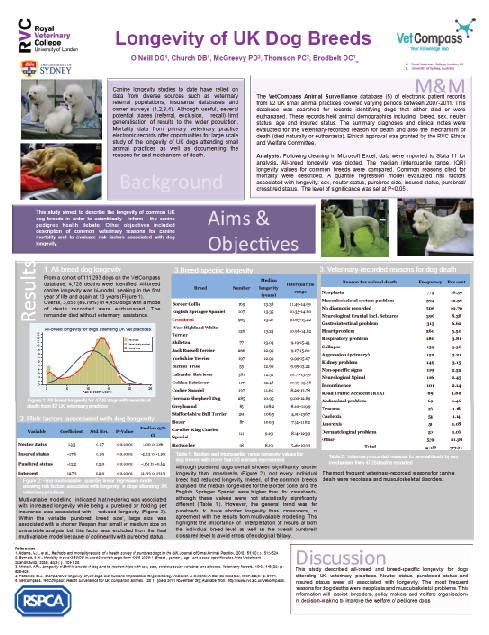O'NEILL, D. G., CHURCH, D. B., MCGREEVY, P. D., THOMSON, P. C. & BRODBELT, D. C. 2013. Longevity and mortality of owned dogs in England. The Veterinary Journal, 198, 638-643.
Improved understanding of longevity represents a significant welfare opportunity for the domestic dog, given its unparalleled morphological diversity. Clinical health data from 102,609 owned dogs attending first opinion veterinary practices (n = 86) in England were analysed. The current findings highlight major breed differences for longevity and support the concept of hybrid vigour in dogs.
Improved understanding of longevity represents a significant welfare opportunity for the domestic dog, given its unparalleled morphological diversity. Epidemiological research using electronic patient records (EPRs) collected from primary veterinary practices overcomes many inherent limitations of referral clinic, owner questionnaire and pet insurance data. Clinical health data from 102,609 owned dogs attending first opinion veterinary practices (n = 86) in central and southeast England were analysed, focusing on 5095 confirmed deaths. Of deceased dogs with information available, 3961 (77.9%) were purebred, 2386 (47.0%) were female, 2528 (49.8%) were neutered and 1105 (21.7%) were insured. The overall median longevity was 12.0 years (IQR 8.9–14.2). The longest-lived breeds were the Miniature poodle, Bearded collie, Border collie and Miniature dachshund, while the shortest-lived were the Dogue de Bordeaux and Great Dane. The most frequently attributed causes of death were neoplastic, musculoskeletal and neurological disorders. The results of multivariable modelling indicated that longevity in crossbred dogs exceeded purebred dogs by 1.2 years (95% confidence interval 0.9–1.4; P < 0.001) and that increasing bodyweight was negatively correlated with longevity. The current findings highlight major breed differences for longevity and support the concept of hybrid vigour in dogs.

Poster: longevity_of_uk_dog_breeds.pdf
UK - Additional longevity research...
Longevity and mortality in Kennel Club registered dog breeds in the UK in 2014 is available via Canine Genetics and Epidemiology (2018).
Longevity and mortality in Kennel Club registered dog breeds in the UK in 2014
Authors
T. W. Lewis1,2*, B. M. Wiles1, A. M. Llewellyn-Zaidi3, K. M. Evans1,2 and D. G. O’Neill4
Abstract
Background:
The domestic dog is one of the most diverse mammalian species, exhibiting wide variations in morphology, behaviour and morbidity across breeds. Therefore, it is not unexpected that breeds should also exhibit variation in mortality and longevity. While shorter longevity per se may not necessarily be a welfare issue, a generally foreshortened lifespan in a breed that is accompanied by a high prevalence of a particular cause of death may reveal potentially serious welfare concerns and highlight scope to improve breed welfare. Survey data gathered directly from owners offer useful insights into canine longevity and mortality that can support the overall evidence base for welfare reforms within breeds.
Results:
Mortality data on 5663 deceased dogs registered with the UK Kennel Club were collected from an owner-based survey. The most commonly reported causes of death were old age (13.8%), unspecified cancer (8.7%) and heart failure (4.9%); with 5.1% of deaths reported as unknown cause. Overall median age at death was 10.33 years (interquartile range: 7.17 – 12.83 years). Breeds varied widely in median longevity overall from the West Highland Terrier (12.71 years) to the Dobermann Pinscher (7.67 years). There was also wide variation in the prevalence of some common causes of death among breeds, and in median longevity across the causes of death.
Conclusion:
Substantial variation in the median lifespan and the prominent causes of death exists across breeds. This study has identified some breeds with both a low median lifespan and also a high proportional mortality for one or more specific causes of death that should be considered as both potential welfare concerns as well as opportunities for improvement.
Keywords:
Pedigree, Lifespan, Purebred, Death, Healthspan, Predisposition, Mortality, Longevity
Comments from author and IPFD team member, Aimee Llewellyn-Zaide...
"This research used mortality data to describe the life spans and causes of death for more than 5600+ pedigreed dogs, across many breeds, registered with the UK Kennel Club. Unsurprisingly, there is a great deal of variation between breeds for both the average age of death, and the causes of death. While many dogs succumb to “old age,” in some breeds there were causes of death that appeared to be more common than across all dogs. While longevity doesn’t automatically indicate high welfare, it can serve as one indication of a breed’s over-all robustness.
The information in this paper may be useful in helping prioritize disease concerns within breeds – perhaps resulting in increasing longevity as well as improving welfare within a breed.
This paper may also provide a useful baseline for breeds to measure improvements in longevity against. However, it should also be noted that the paper highlights some challenges when interpreting the data – notably that not all breeds are represented in high numbers, and causes of death cannot always be categorized into likely heritable or not (i.e. hereditary epilepsy vs. road traffic accidents). For those readers who are interested in prioritizing diseases/breeding concerns, Fig. 5’s methods for simplified categorizing of longevity vs predominant causes of death could be usefully adapted to a breed-level."
 Donate
Donate

Recommended Comments
There are no comments to display.
Join the conversation
You can post now and register later. If you have an account, sign in now to post with your account.
Note: Your post will require moderator approval before it will be visible.